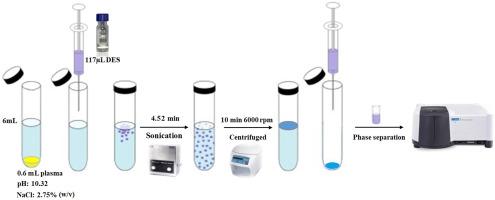Ultrasound-assisted emulsification-microextraction of propranolol in plasma using a natural hydrophobic deep eutectic solvent for fluorescence detection: A green analytical approach
IF 5.8
2区 化学
Q2 CHEMISTRY, MULTIDISCIPLINARY
引用次数: 0
Abstract
This study aimed to explore and assess the feasibility of measuring propranolol within the hydrophobic deep eutectic solvent (NHDES) as an extractant using a spectrofluorometer. Accordingly, the optimization and application of an ultrasound-assisted emulsification microextraction (USAEME) method, employing NHDES to extract propranolol prior to determination by a spectrofluorometer, were investigated. The NHDES was prepared using fatty acids, which act as both hydrogen bond acceptors and donors. The fluorescence spectra of propranolol in methanol, NHDES, and a mixture of methanol and NHDES were analyzed. The study further explored the selection of NHDES composition using a univariate method and examined the effects of other parameters including NHDES volume, pH, salt concentration, and sonication time through a multivariate optimization approach. Optimal extraction conditions were identified, and the method's analytical performance was validated using plasma samples. The calibration curve exhibited good linearity (R2 = 0.9977), with limits of detection (LOD) and quantitation (LOQ) of 11.62 and 35.22 ng/mL, respectively. The method demonstrated excellent precision, making it a reliable technique for the extraction and quantification of propranolol in complex matrices. Additionally, the Complex Green Analytical Procedure Index (ComplexGAPI) tool was employed to evaluate the method's environmental impact, confirming its superior greenness compared to other methods.

超声辅助乳化-用天然疏水深共熔溶剂微萃取血浆中的心得安荧光检测:一种绿色分析方法
本研究旨在探索和评估使用荧光分光光度仪在疏水深共熔溶剂(NHDES)中作为萃取剂测量心得安的可行性。为此,研究了超声辅助乳化微萃取(USAEME)方法的优化和应用,即利用NHDES提取普萘洛尔,然后用荧光光谱仪测定。NHDES是用脂肪酸制备的,脂肪酸既是氢键受体又是给体。分析了普萘洛尔在甲醇、NHDES和甲醇与NHDES混合物中的荧光光谱。本研究采用单变量方法进一步探索了NHDES组成的选择,并通过多变量优化方法考察了NHDES体积、pH、盐浓度、超声时间等其他参数的影响。确定了最佳提取条件,并用血浆样品验证了该方法的分析性能。标定曲线线性良好(R2 = 0.9977),检出限和定量限分别为11.62和35.22 ng/mL。该方法精密度高,可用于复杂基质中普萘洛尔的提取和定量。此外,利用复杂绿色分析程序指数(ComplexGAPI)工具对该方法的环境影响进行了评价,证实了该方法的绿色程度优于其他方法。
本文章由计算机程序翻译,如有差异,请以英文原文为准。
求助全文
约1分钟内获得全文
求助全文
来源期刊

Sustainable Chemistry and Pharmacy
Environmental Science-Pollution
CiteScore
8.20
自引率
6.70%
发文量
274
审稿时长
37 days
期刊介绍:
Sustainable Chemistry and Pharmacy publishes research that is related to chemistry, pharmacy and sustainability science in a forward oriented manner. It provides a unique forum for the publication of innovative research on the intersection and overlap of chemistry and pharmacy on the one hand and sustainability on the other hand. This includes contributions related to increasing sustainability of chemistry and pharmaceutical science and industries itself as well as their products in relation to the contribution of these to sustainability itself. As an interdisciplinary and transdisciplinary journal it addresses all sustainability related issues along the life cycle of chemical and pharmaceutical products form resource related topics until the end of life of products. This includes not only natural science based approaches and issues but also from humanities, social science and economics as far as they are dealing with sustainability related to chemistry and pharmacy. Sustainable Chemistry and Pharmacy aims at bridging between disciplines as well as developing and developed countries.
 求助内容:
求助内容: 应助结果提醒方式:
应助结果提醒方式:


